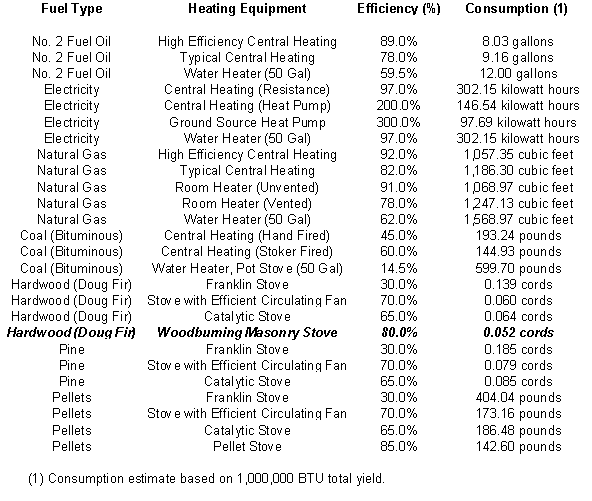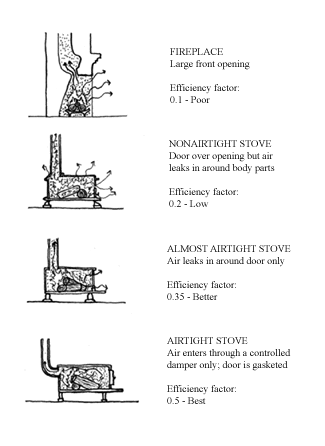

 |
|
 |
If on site combustion seems to be a viable source of heat for your home, here are a few things to consider.
FUEL COMPARISON CHART

STOVE EFFICIENCY
There are various kinds of wood burning stoves that should be considered for specific needs.

The most essential difference between these stoves
is how the combustion air which enters the stove is controlled. Generally,
as the air control increases, efficiency increases.
In an airtight stove, almost all the oxygen which
enters the stove is consumed in the combustion of the wood. The rest
of the air (primarily nitrogen) and the combustion products (primarily
carbon dioxide, carbon monoxide, and water vapor) are heated to very high
temperatures and vented to the outside through the chimney. The controlled
airflow results in a lower rate of heat production, but a greater total
heat output.
In the noncontrollable stoves, there is a large
quantity of air that enters which is not involved in the combustion.
This air is heated and released along with the above mentioned combustion
gases into the atmosphere. The excess air results in excess heat
being lost through the chimney. In this type of system, excessive
airflows result in lower firebox temperatures leading to incomplete combustion.
As a result, non-airtight stoves require more frequent ash clean-outs compared
to airtight stoves which usually go for weeks without cleaning.
WOOD STORAGE
An important consideration (often overlooked) is
how to dry your wood and keep it dry. Moisture content is an important
factor in the overall BTU output in wood-heating systems. A moisture
level of 20% is considered to be acceptable for efficient combustion.
There is also a safety concern relating to the moisture content of wood.
Creosote, the condensed acids and gasses found in wood smoke, can build
up on the interior chimney walls and actually ignite. The best way
to avoid creosote build-up is to only burn wood that has been dried to
the 20% moisture content level.
In the Leonard's case, their wood storage shed not
only provides dry storage, but is designed to allow wood to dry for one
year before use. A one-year drying period assures a moisture content
well below 20% maximizing heat output and minimizing creosote build-up.
WOOD SUPPLY
Considerations should also be given to the accessibility of wood for on site burning. The Leonard's house in Veneta is situated on twenty acres of private land. Their wood supply is derived from fallen trees on their property which is periodically harvested. A relatively small bundle of wood (consisting of (4) four inch diameter by eighteen inches long doug fir logs) is burned once a day during the winter for sufficient heat throughout their home. It is important to first understand how much heat is required to heat a home relative to its square footage, amount of heat lost to the outdoors through the envelope, and the outdoor air temperature of the site. These factors are important determinants of whether this form of heating is appropriate for your home.
POLLUTION
A non airtight wood-burning appliance or fireplace
may emit large quantities of pollutants. Wood smoke contains pollutants
such as nitrogen oxides, carbon monoxide, organic gases, and particulate
matter. Many of these pollutants can have a negative impact on the
environment as well as causing serious health problems for people.
In many urban and rural areas, wood smoke is a major factor in an increased
level of air pollution.
In the Leonard's case an airtight masonry stove
uses less wood to produce more heat. Burning wood that has been split
and dried for approximately one full year contributes to cleaner combustion.
A smaller, hotter fire burns much more efficiently and in turn produces
much less pollution.
** additional information on alternative sources of energy and on air pollution from wood stoves is available from:
 |
|
 |